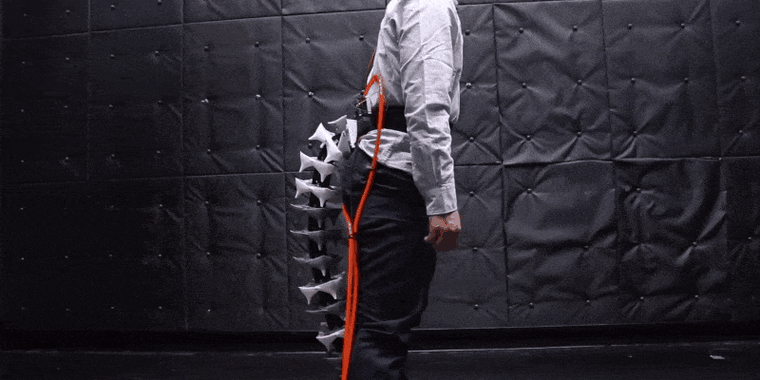Evolution gave human ancestors big brains and bipedalism, among other attributes that our species has retained to this day. But it took away their tails.
Now, designers in Japan are looking to give them back.
A team at Keio University in Tokyo has created a jointed appendage worn at the waist that they say could help steady people with balance problems and provide an extra margin of safety for construction workers and other physical laborers working in precarious or physically challenging environments.
The robo-tail, which was presented in July at a conference in Los Angeles, looks cute, in a T. rex sort of way. But the researchers say the tail is less about being adorable and more about augmenting our physical abilities.
“In some situations, our bodies may lack the ability to support or balance us, such as in scenarios with poor footing balance,” Junichi Nabeshima, a member of the team and a graduate student at the university, told NBC News MACH in an email. “Although human bodies don’t have a functional tail as other animals, we see the [potential of biomimicking tails] for the field of human augmentation and adding new functions to our bodies.”
Nabeshima said he and his collaborators modeled the pneumatic appendage not on the tails of monkeys or other mammals but on a seahorse’s tail, whose boxy vertebrae give it remarkable strength. Their prototype, dubbed Arque (for Artificial Biomimicry-Inspired Tail for Extending Innate Body Functions), is made of a string of artificial vertebrae and actuated by artificial muscles — strategically placed balloons that expand and contract in response to compressed air fed to the apparatus via hoses.
A video shows how the tail could boost balance. As the wearer bends over, the tail automatically curls up like that of a curious cat; when he stands back up, the tail flops down. When the wearer bends his torso to the left, the tail swings to the right.
The tail could also be used to disrupt balance — for example, to provide extra realism to virtual reality games. Later in the same video, a wearer equipped with a VR headset and hand controllers plays a game while wearing the tail, which swings around wildly, knocking the user off balance.
Of course, wearing a tail at home is one thing, venturing out in public with it is quite another. Cosplayers and furries might get a kick out of wearing a bobbing, swinging skeletal tail, but construction workers and people with impaired balance might be a harder sell.
But James Patton, a professor of bioengineering at the University of Illinois at Chicago, offered an upbeat assessment of the tail’s commercial potential. “I love the idea,” he said. “It’s got just the right amount of wackiness, I think, to make everybody kind of stimulated.”
Patton said he could see the tail being used in a rehabilitation setting, with patients recovering from neurological or orthopedic injuries wearing the tail as they practice walking on a treadmill. The need for hoses and an air compressor means the tail isn’t truly portable, at least at this point, but he predicted that despite its limitations, the tail would likely “find a niche or two or six or 20.”
This wouldn’t be the first human tail on the market. Since 2015, the London-based Tail Company has sold remote-controlled appendages for cosplay; in 2012, a Tokyo-based design team known as Neurowear created a fluffy tail that wags back and forth in response to signals from a headset that detects brain activity.
It could take years to find out if Patton is right. Nabeshima said the design team is focused not on bringing the tail to market but on making the control mechanism more compact and portable.
For now at least, we’ll have to get by with only our arms and legs.

